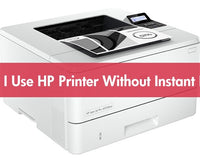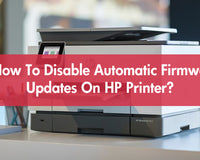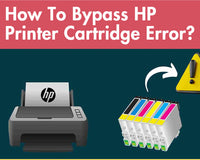Printer errors, including the "printer not responding" issue, can be frustrating for anyone who relies on a printer for their daily tasks. Printer not responding can arise for various reasons, making it challenging to pinpoint the exact cause. However, rest assured that there are several troubleshooting steps in our True Image blog you can take to resolve this issue.
Index
- Check Connection
- Update Driver
- Replace Ink or Paper
- Check Hardware
- Check Printer Settings
- Restart the Printer
- Run the Printer Troubleshooter
Common Causes of Printer Not Responding
🌲Connection Issues:
Problems with the USB, Wi-Fi, or network connection can prevent the printer from communicating with your computer.
🌲Driver Problems:
Outdated, corrupted, or incompatible printer drivers can cause communication errors.
🌲Low Ink or Paper:
If the printer runs out of ink or paper, it may not respond to print commands.
🌲Hardware Issues:
Printer hardware failures, such as a faulty print head or motor, can also lead to this issue.
🌲Printer Settings:
Incorrect printer settings or configurations can cause the printer to malfunction.
Troubleshooting Steps for Printer Not Responding
🍀Check Connection:
Ensure that the printer is properly connected to your computer or network. Check cables for damage and reconnect if necessary. For Wi-Fi printers, check the network settings and signal strength.
|
🍀Update Driver:
Visit the printer manufacturer's website (e.g., Canon or Brother) to download and install the latest printer drivers. Uninstall any existing drivers before installing the new ones. The following are steps for Updating the Driver:
- Press "Win + R," type "devmgmt. msc", and press "Enter."
- In Device Manager, expand the "Printers" category.
- Right-click on your printer and select "Update driver".
- Choose "Browse my computer for driver software."
- Navigate to the folder where you downloaded the latest driver.
- Select the driver file (usually a .inf file) and click "Next".
- Follow the prompts to install the driver.
🍀Replace Ink or Paper:
Check the printer's ink levels and replace any empty cartridges. Ensure that there is enough paper in the tray and that it's loaded correctly.
|
Related Blogs: 🌸 How To Check Ink Levels On HP Printer? 🌸 How to Replace Toner in Brother Printer? 🌸 How to Change Ink on an Epson Printer? |
🍀Check Hardware:
Check the printer for any error messages or indicator lights that might suggest a hardware issue. If you suspect hardware failure, contact the printer manufacturer's customer support or a professional technician for further assistance.
🍀Check Printer Settings:
Open the printer settings on your computer and ensure that the correct printer is selected as the default. Check the print queue for any stuck jobs and cancel them if necessary.
|
Related Blogs:
|
🍀Restart the Printer:
Please turn off the printer, wait a few seconds, and then turn it back on. By restarting the printer, you can resolve temporary glitches or errors.
🍀Run the Printer Troubleshooter:
Most operating systems come with a built-in printer troubleshooter that can help identify and resolve common printer issues, such as printer offline. Press "Win" + "I" to open the Windows Settings. Follow the sequences below to run the printer troubleshooter: "Devices"> "Printers & scanners"> "Manage"> "Run the troubleshooter.
- Restart the Printer Spooler Service:
- Press "Win" + "R" to open the Run dialog window.
- Type "services.msc" and click "OK."
- Find and right-click on "Print Spooler" and then select "Restart".

Prevention and Maintenance for Printer Not Responding
When a printer stops responding, it can disrupt workflow and cause frustration. However, by implementing regular prevention and maintenance practices, you can significantly reduce the likelihood of encountering this issue. Here are some essential steps to keep your printer running smoothly:
🌷Regular Cleaning and Maintenance:
Wipe down the exterior of the printer with a soft, lint-free cloth to remove dust and debris. Clean the print heads and nozzles periodically to prevent clogs and ensure consistent print quality.
🌷Keeping the Printer Driver Up-to-Date:
By regularly checking for and installing these updates, you can ensure that your printer is running at its optimal level. If you're experiencing persistent issues with your printer, uninstalling and reinstalling the driver can sometimes resolve the problem.
🌷Using High-Quality Ink and Paper:
Using original or compatible HP/Brother/Canon ink cartridges and paper that are specifically designed for your printer model can help prevent issues like clogs, smears, and inconsistent print quality. Conversely, low-quality ink and paper can damage your printer's print heads and nozzles, leading to costly repairs.
🌷Avoiding Overworking the Printer:
Sending a large number of print jobs to your printer at once can overwhelm its processing capabilities and cause it to become unresponsive. Instead, manage your print jobs carefully and allow your printer time to cool down between jobs. Additionally, turning off your printer when it's not in use can help conserve energy and reduce wear and tear on its components.
By implementing these prevention and maintenance practices, you can help ensure that your printer remains reliable and responsive, minimizing the risk of costly repairs and downtime. Remember, a little maintenance goes a long way in keeping your printer running smoothly.
Conclusion for Printer Not Responding
The "printer not responding" issue can be frustrating, but with the right troubleshooting steps, you can often resolve it quickly. If you still need help, feel free to seek help from us or your printer manufacturer's support team. Remember, regular maintenance and updates can help prevent printer issues from occurring in the future.
|
Recommended Blogs: |
















